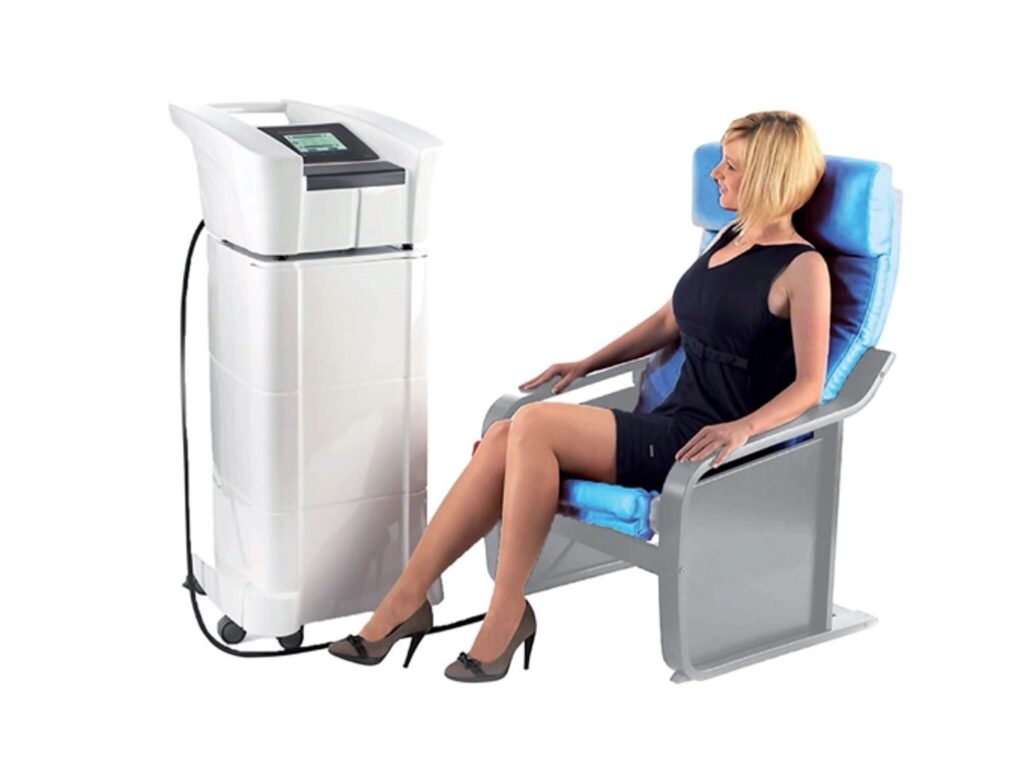
by Iskra Medical
The TESLA Chair is a breakthrough treatment for incontinence and confidence. This unique technology revolutionises sexual health and wellness by providing those suffering from incontinence with a completely non-invasive and effective option for management of symptoms.
TESLAChair for Urinary Incontinence
The TESLAChair was developed for treating weakened pelvic floor muscles and urinary incontinence using the special Functional Magnetic Stimulation (FMS) technology. The pulsed magnetic field generated by the device causes the muscles of the pelvic floor to contract. This therapy is suitable for all kinds of urinary and faecal incontinence. FMS also helps patients with sexual dysfunction and chronic pain in the pelvic region and lumbar spine. The magnetic stimulation results in increased strength and endurance of pelvic region and pelvic floor muscles.
TESLAChair for Lower Back
The new TESLAChair treatment is a painless, non-invasive and effective therapy for problems in the lower back area. The treatment stimulates muscles, and accelerates circulation without direct contact with the skin. The therapy procedure is simple, and the patient does not require special preparation. During the therapy the patient simply sits in the chair. Stimulation of the lower back can be accurately targeted by changing the position of the applicator in the chair backrest.

It is a completely non-invasive treatment option to strengthen the muscles of the pelvic floor, it is very comfortable, you will feel muscle contraction and a series of gentle magnetic tapping sensations in your pelvic floor.
The treatment builds pelvic strength and can help improve symptoms of incontinence in Men and Women. It can also be helpful for Men to improve symptoms of erectile dysfunction.
FMS stands for Functional Magnetic Stimulation which delivers up to 3 tesla. A special magnetic field is generated by a pulse of current inside the EM (electro magnetic) mechanism, and this induces a current that triggers the motor nerve system of the body, stimulating the targeted muscles to contract, and helping to boost circulation and nutrition.
During electromagnetic induction, rapid changes of magnetic field intensity induce an electrical current in the neuron. Once the current reaches a certain value, neuron action potential is achieved. This neuron action potential causes the neuron cell to depolarise, which eventually leads to intense muscle contraction.
The treatment is suitable for all types of urinary and faecal incontinence. It is used for faster rehabilitation after surgeries in the urogenital area, after childbirth and for some sexual dysfunction and chronic pelvic and lower back pain. You will complete a questionnaire and receive a physical examination as part of your assessment for treatment.
Patients are seated and fully clothed for treatment in the comfortable TESLAChair. The therapy is non-invasive, painless and without any known side effects. Patients should feel muscle contraction in the targeted area.
A course of 6 or more treatments is recommended, performed two or three times per week for thirty minutes. For some patients, maintenance treatments may also be recommended.

How it helps?
- Urge urinary incontinence
- Stress urinary incontinence
- Mixed urinary incontinence
- Incontinence after radical prostatectomy
- Faecal incontinence
- Weak pelvic floor muscles
- Erectile dysfunction
- Muscle repair
- Regeneration of pelvic floor health after childbirth
- Rehabilitation after pelvic floor surgery
- Chronic prostate inflammation
Improvements
Urge Incontinence Improvement
89% of patients showed significant or complete dryness.
Stress Incontinence Improvement
95% of patients showed significant or complete dryness.
Mixed Incontinence Improvement
98% of patients showed significant or complete dryness.
After childbirth Incontinence Improvement
100% of patients showed significant or complete dryness.
WHAT & WHERE IS MY PELVIC FLOOR?
Imagine your pelvic floor muscles as a thin trampoline of muscles in between your pelvic bones.
These muscles muscles extend from your pubic bone tail bone to your and span the width of your pelvic bones.
In my opinion the muscles of the pelvic floor are poorly designed (way too thin), they can be weakened by heavy lifting, pregnancy, childbirth, surgery, being overweight, chronic constipation, conditions that cause chronic coughing such as smokers cough, bronchitis and asthma, and simply getting older.
WHAT DOES MY PELVIC FLOOR DO?
In women, the pelvic floor muscles support the bladder, bowel and the uterus.
In men, the pelvic floor muscles support the bladder and bowel.
A properly functioning pelvic floor is essential to maintain bladder and bowel control and prevent involuntary loss of urine, faeces and wind. Particularly when we play sport, run, jump, cough, laugh, sneeze or lift heavy things.
It also plays an important role in sexual sensation for both men and women.
If pelvic floor muscles are weakened our internal organs are no longer fully supported and this can lead to pelvic organ prolapse, and sensation of heaviness in the pelvis. Weakened pelvic floor muscles can also contribute to involuntary loss of urine, faeces and wind.
The great news is that pelvic floor muscles will usually become stronger from a regular exercise program. However some people struggle to isolate the pelvic floor muscles correctly or don’t activate the correct muscles when doing their pelvic floor exercises. Some people just cannot engage these muscles enough or do their kegels often enough to make a significant enough difference to the strength of their pelvic floor.
TESLA Chair treatments are totally non-invasive, they are particularly attractive to patients who are keen to avoid the risks and downtime associated with surgery. It is important to note that Tesla Chair cannot give the same results as surgery should your condition be severe. People who are not suitable candidates for surgery can still do Tesla Chair treatments as even small improvements in muscle strength may improve your quality of life
IS A LITTLE BIT OF LEAKAGE NORMAL?
Whilst it is very common to occasionally pass wind without meaning to (in pilates class, or when running or jumping), or have a small leak of wee when you cough or sneeze, particularly after childbirth or lots of heavy lifting in your life, it is not normal. It is a sign of pelvic floor weakness and can be addressed. This weakness can deteriorate to a complete lack of control over the bladder or bowel, regular pelvic floor exercises are recommend for all individuals. Incontinence can have a huge impact on all areas of a persons life including self esteem, wellbeing, and quality of life, particularly when it restricts activities or attending events.
Women make up 80% of people who report living with incontinence, most often during pregnancy, after childbirth, as well as during or after menopause. 1 in 3 women who have a baby will experience incontinence, this risk increases the more babies a woman has.
For Men, it is common for prostate issues to cause urinary incontinence, most men (60-100%) post radical prostatectomy experience stress incontinence post surgery, or after radiation treatment for prostate cancer. This can be one of the greatest challenges to manage.
INCONTINENCE
is a term that describes any accidental or involuntary loss of; urine from the bladder (Urinary incontinence) or bowel motion, faeces or wind from the bowel (faecal incontinence). Incontinence ranges in severity, from the loss of a few drops of urine with a sneeze or cough or a tiny amount of brown staining in underwear to a complete lack or control over the bladder or bowel. Severe incontinence is defined as requiring assistance with bladder or bowel control and or the use of products. Women make up 80% of people who report living with incontinence. Often during and after pregnancy or childbirth or after menopause. 1 in 3 women who have a baby will experience incontinence, this risk increases the more babies a woman has.
During menopause oestrogen is produced in lower amounts. Oestrogen helps to maintain the thickness of the urethral lining to keep the urethra sealed after passing urine. As a result of this loss of oestrogen some women experience stress incontinence during menopause.
It is normal to for the bladder to hold 1 1/2 -2 cups of water during the day, and up to 4 cups at night. It is normal to get up to pass urine once a night.
TYPES OF INCONTINENCE
STRESS INCONTINENCE: Leaking small amounts during activity involving physical exertion or effort. This is common after childbirth or surgery that can weaken the pelvic floor. Many men develop stress incontinence after prostate surgery or after radiation treatment for prostate cancer. The prostate surrounds the bladder and when it is removed or affected this can sometimes cause damage to the nerves and muscles of the bladder, urethra, and or the sphincter which controls the passage of urine from the bladder.
URGE INCONTINENCE: Needing to go all of a sudden and not being able to hold on, particularly when there is only a small amount to be passed (bladder is not full). This can also be called unstable or overactive ladder or detrusor instability.
MIXED INCONTINENCE: It is common for people to suffer a combination of stress and urge incontinence.
OVERFLOW INCONTINENCE: Often associated with chronic urinary retention, this involves a small involuntary release of urine from an overfull bladder, full emptying often does not occur. This often happens without the person feeling any urge to urinate.
FUNCTIONAL INCONTINENCE: a form of incontinence when a person is usually aware of the need to pass urine or faeces but for physical or mental reasons they are unable to get to the bathroom. Causes can range from dementia, impaired mobility, severe depression or anxiety.
I am a fit and healthy relatively young woman. I have 2 teenagers now.
I noticed my pelvic floor had less sensation after my 2 vaginal births, they were not particularly big babies, all the same they came crashing down the birth canal like freight trains not minding what was in their way. I felt I had pretty good control in the early years after childbirth (I still said a little prayer in pilates & occasionally crossed my legs when laughing), but I noticed further deterioration as I aged. I engaged a wonderful pelvic floor physio (which I highly recommend anyone struggling with their pelvic floor to do) & did my regular kegel exercises, I adjusted my gym routines to avoid putting too much load on my pelvic floor and added pelvic floor exercises into my sets on the mat, I did this regularly. It was not enough.
After a series of treatments on the Tesla Chair I now find it much easier to activate my pelvic floor muscles (I can actually feel it now, I feel there is a sensation of a lot more muscle movement when I engage those muscles and I can engage them quickly and effectively when I need to). I can run comfortably without an annoyed bladder sensation & I don’t need to stop to wee. I can jump on a trampoline more confidently, have less need for panty liners, and do much better when coughing or sneezing. I have increased confidence, can exercise more comfortably and at a higher intensity.
I have found this benefits my general strength, fitness and supports my mental health. Strengthening my pelvic floor has helped to remove one barrier to exercise, which benefits us in a multitude of ways. I continue to do my kegel exercises and will re-treat with the chair as required to maintain a strong pelvic floor. As well as having the MediSpa full time I work in a public emergency department as a Registered Nurse, it is a busy job, and I often have to hold on to my toilet calls. I can now do this with confidence! It is worth mentioning that in this role I see a huge number of my patients suffering with urinary tract infections and incontinence. It saddens me, and it is fantastic that there are options for treatment to improve your pelvic floor strength and increase continence when standard techniques are not enough.



